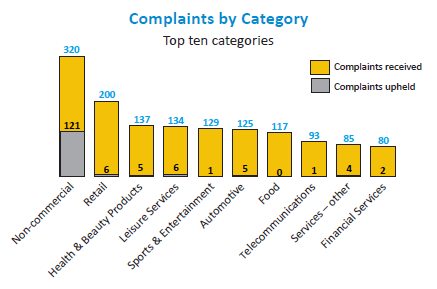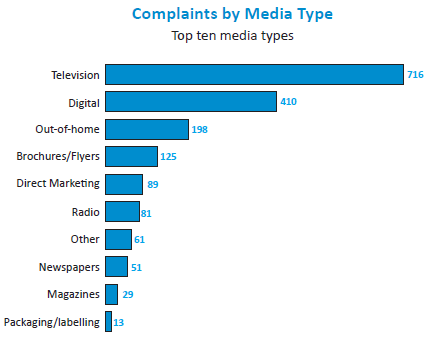Marketers who want to avoid having complaints lodged against them should ensure their ads include all relevant information, clearly state all pertinent details of an offer, avoid unsubstantiated claims – and rethink how provocative they want their ads to be if they work in the non-profit industry, according to the latest Ad Standards complaints report.
Released last week, the report divides the 1,808 complaints submitted last year in several ways. The most common clauses allegedly broken were numbers 1 and 3, Accuracy and Clarity and Price Claims, respectively. Of the complaints filed, 767 fell into one of these two categories, and 156 of them, covering 37 ads, were deemed valid by Ad Standards.
These valid complaints “involved advertisements that omitted relevant information, did not clearly state all pertinent details of an offer, and contained unsubstantiated claims,” according to the organization’s report.
The second most common clause allegedly violated was number 14 – Unacceptable Depictions and Portrayals, with 471 complaints covering 256 ads submitted. Of these, Ad Standards reviewed and upheld 128 complaints covering seven ads.
“Most complaints evaluated under Clause 14 involve subjective matters of personal taste or preference and do not ultimately raise issues under the Code,” the report says.
The third most common clause allegedly broken was number 10 – safety – with 65 complaints submitted covering 43 ads. Of these, two were deemed valid by the council, regarding two separate ads.
When the complaints were divided by category of advertising, non-commercial entities took the top spot for the first time in Ad Standards’ 51-year history, with 320.
“This can be attributed to the 100 plus complaints submitted by consumers about images they found unacceptably graphic and disturbing used in advertising by an advocacy organization,” Ad Standards’ report notes, without identifying the organization. Retail, which traditionally generates the highest number of complaints, came in second place with 200 complaints, followed by health and beauty products, with 137 complaints.

And as for complaints by media type, television once again took the top spot, with 716 complaints, followed by digital advertising with 410, and billboards, transit, and other outside media with 198 complaints.

Complaints regarding digital advertising primarily related to advertiser-owned websites, the report notes.
According to a March 28 statement by Ad Standards vice president Janet Feasby, the number of complaints submitted rose between 2016 and 2017, with 1,639 complaints submitted in the former versus 1,808 in the latter.
Three case studies of certifiably bad advertising
The report includes three illuminating case studies of ads that were found to be violating the organization’s standards.
The first, which Ad Standards concluded broke Clause 1 (Accuracy and Clarity) and Clause 2 (Disguised Advertising), had been presented as sponsored content in online publication Insauga, but did not clarify who the sponsor was as it described the features of a large retail outlet in Mississauga.
“To Council, the ‘article’ gave the impression of being a self-congratulatory press release,” the report says. “Although the words ‘Sponsored Post’ appeared at the beginning of the article,
the actual identity of the sponsor of the ‘article’ or ‘post’ was not clearly identified… Council also concluded that the advertisement was presented in a format and style that concealed the fact that it was an advertisement.”
The second, by Clearview Antenna, violated Clause 7, Testimonials, by featuring testimonials on its Facebook page from customers who supposedly lived in Montreal, Toronto, and Vancouver.
However, the testimonials were proven false because the company’s American website featured the exact same testimonials from the same individuals, but identified them as living in Indianapolis, Palo Alto, and Chicago. (It’s worth noting that the three testimonials on the company’s American site are still from Indianapolis, Palo Alto, and Chicago.)
The third, by an unidentified travel organization, was found to have violated Clause 2, Disguised Advertising Techniques, and Clause 7, Testimonials, when it hired a U.K. blogger to promote Ottawa as an attractive travel destination, which the person submitting the complaint alleged was not identified as sponsored content.
“The advertiser had contracted with the blogger to write, for a UK audience, social media posts about the blogger’s trip to Canada,” the report says. “Because the post did not clarify that it was sponsored, [Ad Standards] found that the post was disguised advertising.”
The advertiser was not identified, the report notes, because the ad was permanently removed before the Ad Standards Council could formally meet to review the complaint.





